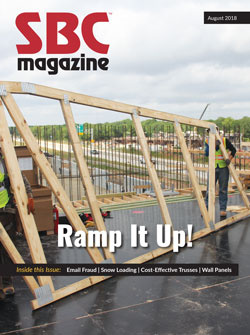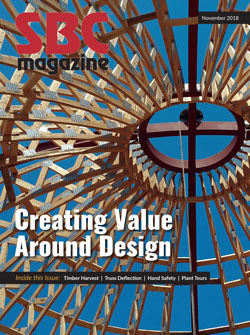Search
The below article is an update of the article, "Who's Mold Is It?" published in the January/February 2003 edition of SBC Magazine.
Builder complaints regarding the growth of surface mold on the lumber contained within wood structural components, while not as frequently encountered as in the past, continue to pose a dilemma in some markets. The dilemma comes in the form of builders either demanding moldfree wood based products, or when mold appears on a component at the jobsite, they are demanding that suppliers provide an immediate remediation (e.g., removal) of the mold, regardless of the cause or the cost. And, where structures are improperly designed or constructed and mold growth appears years later, component manufacturers (CMs) have found themselves into construction defect litigation with various types of complaints being asserted.
Mold contamination is becoming a nationwide concern among homeowners and builders. Mold in homes and mold lawsuits have gained extensive media coverage from talk shows to feature articles in national publications. Even Erin Brockovich is making news in the mold litigation arena. Insurance companies are becoming increasingly concerned as well. They feel that they are unfairly bearing the brunt of the expense in remediating mold, thereby leading to revisions in homeowner and builder/contractor liability policies.
Mold can be found almost anywhere and can grow on virtually any substance, provided moisture is present. Several lumber associations are knowledgeable on this topic, including the American Forest & Paper Association's (AF&PA’s) American Wood Council (AWC), the Western Wood Products Association (WWPA), the Canadian Wood Council (CWC), and the Southern Pine Council (SPC). Surface molds, which can come from a variety of sources including airborne spores, feed off of the sugars and starches readily available in wood. Thus mold can and will occur naturally on lumber under certain conditions, normally due to the presence of moisture in or on the wood and warm temperatures. Therefore, component manufacturers and lumber dealers must realize that all lumber and wood components are susceptible to mold growth.
According to some media reports, toxic mold poses a major risk to the health of Americans. Although there is little scientific basis for these claims, the headlines have caused many homeowners to focus on mold.

Articles
The housing industry is clearly firing on all cylinders, even as labor constraints and building material prices are repeatedly brought up as headwinds for the housing market.
Testing is underway to determine the effects of weather exposure and time on trusses.
If you use email, you want to prevent spoofing.
A spring Wisconsin snowstorm demonstrates how a building design practice may lead to higher risk.
Framers and CMs can make for a powerful partnership, but it takes work.
Trusses provide a cost-effective, responsive solution to concrete formwork.
How a better understanding of human needs can improve employee retention.
In June, SBCA members traveled to Washington, DC to meet with their members of Congress to discuss immigration and trade policy.
Last year during SBCA’s Open Quarterly Meeting in Baltimore, Maryland, I took the train down to Washington, DC and met with staff members of my U.S. Representative, Bill Flores. After a productive meeting on Capitol Hill, I made sure to leave an invitation behind for the Congressman to tour our production facility in Lott, Texas.

Articles
The Story of Rehkemper and Son, Inc.
Annandale Millwork is embracing the energy code.
Everyone learns a little differently, so mix up your training.
Student Day at BCMC is an opportunity to bring components to life for students.
The 2018 BCMC show runs from October 23-26 in Milwaukee, Wisconsin.
Two skills every CM needs to get stuff done
Builders FirstSource • Albemarle, North Carolina
The educational sessions at BCMC have always been one of our favorite parts of the show. Where else can you go to gather so many new ideas, tips and best practices specific to our industry?
Wescana Industries is a manufacturer of truss production machinery. Our product line includes, roller gantries, finish presses, truss stackers, hydraulic presses, conveyor systems and floor truss machines. Wescana also provides parts and service for all makes and models of machinery. Please visit our website for detailed information on our machinery line.

Articles
At BCMC in Milwaukee last month, a group of component manufacturers (CMs) from across the country hosted the show’s first roundtable focused on employee incentive programs.

